Thermal Comfort of Nelore Cattle (Bos indicus) Managed in Silvopastoral and Traditional Systems Associated with Rumination in a Humid Tropical Environment in the Eastern Amazon, Brazil
Abstract
:Simple Summary
Abstract
1. Introduction
2. Materials and Methods
2.1. Ethical Aspects
2.2. Location
2.3. Experimental Animals, Management and Characterization of the Production System
- i.
- Traditional System (TS)—No shade and no access to the bathing area. In this system, the animals are grazed without the presence of trees or other elements that can provide shade, and they do not have access to a bathing area.
- ii.
- Silvopastoral System (SP)—With shade and without access to the bathing area. In this system, the animals are subjected to pasture with the presence of trees and other elements that can provide shade.
2.4. Agrometeorological Variables
2.5. Physiological Variables
2.6. Respiratory Rate (RR)
2.7. Rectal Temperature (RT)
2.8. Infrared Thermography
2.9. Index to Assess Thermal Comfort
2.9.1. Temperature and Humidity Index (THI)
2.9.2. Black Globe Temperature and Humidity Index (BGHI)
2.10. Behavioral Assessment
2.11. Data Analysis
3. Results
4. Discussion
5. Conclusions
Author Contributions
Funding
Institutional Review Board Statement
Informed Consent Statement
Data Availability Statement
Acknowledgments
Conflicts of Interest
References
- OIE (Organização Mundial de Saúde Animal). Definição de Bem-Estar Animal. 2019. Available online: https://www.oie.int/en/what-we-do/standards/codes-and-manuals/terrestrial-manual-online-access/ (accessed on 9 August 2023).
- Silva, W.C.D.; Silva, J.A.R.D.; Camargo-Júnior, R.N.C.; Silva, É.B.R.D.; Santos, M.R.P.D.; Viana, R.B.; Silva, A.G.M.E.; Silva, C.M.G.D.; Lourenço-Júnior, J.D.B. Animal welfare and effects of per-female stress on male and cattle reproduction—A review. Front. Vet. Sci. 2023, 10, 1083469. [Google Scholar] [CrossRef]
- Broom, D.M. Bem-estar animal. In Comportamento Animal, 2nd ed.; Yamamoto, M.E., Volpato, G.L., Eds.; UFRN: Natal, Brazil, 2011; pp. 457–482. [Google Scholar]
- Bousfield, B.; Brown, R. Animal welfare. Vet. Bull. 2010, 1, 1–12. [Google Scholar]
- Appleby, M.C.; Olsson, A.S.; Galindo, F. Animal Welfare; Cabi: Wallingford, UK, 2018. [Google Scholar]
- Berman, A. Estimates of heat stress relief needs for Holstein dairy cows. J. Anim. Sci. 2005, 83, 1377–1384. [Google Scholar] [CrossRef]
- Farooq, U.; Samad, H.A.; Shehzad, F.; Qayyum, A. Physiological responses of cattle to heat stress. World Appl. Sci. J. 2010, 8, 38–43. [Google Scholar]
- Rashamol, V. Adaptabilidade fisiológica da pecuária ao estresse térmico: Uma revisão atualizada. J. Anim. Behav. Biometeorol. 2018, 6, 62–71. [Google Scholar] [CrossRef]
- Collier, R.J.; Baumgard, L.H.; Zimbelman, R.B.; Xiao, Y. Heat stress: Physiology of acclimation and adaptation. Anim. Front. 2019, 9, 12–19. [Google Scholar] [CrossRef]
- Cartwright, S.L.; Schmied, J.; Karrow, N.; Mallard, B.A. Impact of heat stress on dairy cattle and selection strategies for thermotolerance: A review. Front. Vet. Sci. 2023, 10, 1198697. [Google Scholar] [CrossRef]
- Mateescu, R.G.; Sarlo Davila, K.M.; Hernandez, A.S.; Andrade, A.N.; Zayas, G.A.; Rodriguez, E.E.; Dikmen, S.; Oltenacu, P.A. Impact of Brahman genetics on skin histology characteristics with implications for heat tolerance in cattle. Front. Genet. 2023, 14, 1107468. [Google Scholar] [CrossRef] [PubMed]
- Armstrong, D. Heat stress interaction with shade and cooling. J. Dairy Sci. 1994, 77, 2044–2050. [Google Scholar] [CrossRef]
- Avendaño-Reyes, L. Heat stress management for milk production in arid zones. In Milk Production-An Up-to-Date Overview of Animal Nutrition, Management and Health; IntechOpen: London, UK, 2012. [Google Scholar] [CrossRef]
- Šímová, V.; Večerek, V.; Passantino, A.; Voslárová, E. Pre-transport factors affecting the welfare of cattle during road transport for slaughter–a review. Acta Vet. Brno 2016, 85, 303–318. [Google Scholar] [CrossRef]
- Krishnan, G.; Bagath, M.; Pragna, P.; Vidya, M.K.; Aleena, J.; Archana, P.R.; Sejian, V.; Bhatta, R. Mitigation of the heat stress impact in livestock reproduction. Theriogenology 2017, 8, 8–9. [Google Scholar] [CrossRef]
- Lemes, A.P.; Garcia, A.R.; Pezzopane, J.R.M.; Brandão, F.Z.; Watanabe, Y.F.; Cooke, R.F.; Sponchiado, M.; de Paz, C.C.P.; Camplesi, A.C.; Binelli, M.; et al. Silvopastoral system is an alternative to improve animal welfare and productive performance in meat production systems. Sci. Rep. 2021, 11, 14092. [Google Scholar] [CrossRef] [PubMed]
- Silva, W.C.D.; Silva, É.B.R.D.; Santos, M.R.P.D.; Camargo Junior, R.N.C.; Barbosa, A.V.C.; Silva, J.A.R.D.; Vinhote, J.A.; Sousa, E.D.V.D.; Lourenço Júnior, J.D.B. Behavior and thermal comfort of light and dark coat dairy cows in the Eastern Amazon. Front. Vet. Sci. 2022, 9, 1006093. [Google Scholar] [CrossRef] [PubMed]
- Silva, W.C.D.; Silva, J.A.R.D.; Silva, É.B.R.D.; Barbosa, A.V.C.; Sousa, C.E.L.; Carvalho, K.C.D.; Santos, M.R.P.D.; Neves, K.A.L.; Martorano, L.G.; Camargo Júnior, R.N.C.; et al. Characterization of Thermal Patterns Using Infrared Thermography and Thermolytic Responses of Cattle Reared in Three Different Systems during the Transition Period in the Eastern Amazon, Brazil. Animals 2023, 13, 2735. [Google Scholar] [CrossRef] [PubMed]
- Albright, J.L.; Arave, C.W. The Behaviour of Cattle; CAB International: Wallingford, UK, 1997. [Google Scholar] [CrossRef]
- Terlouw, E.M.C.; Arnould, C.; Aupérin, B.; Berri, C.; Le Bihan-Duval, E.; Deiss, V.; Lefèvre, F.; Lensink, B.J.; Mounier, L. Pre-slaughter conditions, animal stress and welfare: Current status and possible future research. Animals 2008, 2, 1501–1517. [Google Scholar] [CrossRef] [PubMed]
- Fernandes, T.A.; Costa, P.T.; Farias, G.D.; Vaz, R.Z.; Silveira, I.D.B.; Moreira, S.M.; Silveira, R.F. Características comportamentais dos bovinos: Aspectos básicos, processo de aprendizagem e fatores que as afetam. REDVET Rev. Electrónica Vet. 2017, 18, 1–16. [Google Scholar]
- Brown-Brandl, T.M. Understanding heat stress in beef cattle. Rev. Bras. Zootec. 2018, 47, e20160414. [Google Scholar] [CrossRef]
- Mellor, D.J.; Stafford, K.J. Animal welfare implications of neonatal mortality and morbidity in farm animals. Vet. J. 2004, 168, 118–133. [Google Scholar] [CrossRef]
- Dikmen, S.; Hansen, P.J. Is the temperature-humidity index the best indicator of heat stress in lactating dairy cows in a subtropical environment? J. Dairy Sci. 2009, 92, 109–116. [Google Scholar] [CrossRef] [PubMed]
- Mata, B.C.; Pires, M.D.F.Á.; Marques, L.C.G.; Porto, B.R.; de Carvalho Junior, I.S. Comportamento diurno de vacas Holandesas puras por cruza em ambiente quente. Cad. Ciências Agrárias 2016, 8, 49–56. [Google Scholar]
- Summer, A.; Lora, I.; Formaggioni, P.; Gottardo, F. Impact of heat stress on milk and meat production. Anim. Front. 2019, 9, 39–46. [Google Scholar] [CrossRef] [PubMed]
- Godde, C.; Mason-D’Croz, D.; Mayberry, D.; Thornton, P.K.; Herrero, M. Risk of climate-related impacts on the livestock sector: A review of the evidence. Glob. Food Secur. 2021, 28, 100488. [Google Scholar] [CrossRef] [PubMed]
- Knizkova, I.; Petr, K.U.N.C.; Gürdil, G.; Pinar, Y.; Selvi, K.Ç. Applications of infrared thermography in animal production. Anadolu Tarım Bilim. Derg. 2007, 22, 329–336. [Google Scholar]
- McManus, C.; Tanure, C.B.; Peripolli, V.; Seixas, L.; Fischer, V.; Gabbi, A.M.; Menegassi, S.R.O.; Stumpf, M.T.; Kolling, G.J.; Dias, E.; et al. Infrared thermography in animal production: An overview. Comput. Electron. Agric. 2016, 123, 10–16. [Google Scholar] [CrossRef]
- Silva, W.C.; Martorano, L.G.; Silva, L.K.X.; Costa Guedes, J.C.; Fernandes, G.B.; dos Santos, A.X.; Silva, É.B.R. Use of infrared thermography in the assessment of mammary glands and eyeballs in dairy cattle in Western Pará. Res. Soc. Dev. 2020, 9, e46191211421. [Google Scholar] [CrossRef]
- Brcko, C.C.; Silva, J.A.R.D.; Martorano, L.G.; Vilela, R.A.; Nahúm, B.D.S.; Silva, A.G.M.; Barbosa, A.V.C.; Bezerra, A.S.; Lourenço Júnior, J.D.B. Infrared thermography to assess thermoregulatory reactions of female buffaloes in a humid tropical environment. Front. Vet. Sci. 2020, 7, 180. [Google Scholar] [CrossRef] [PubMed]
- Mota-Rojas, D.; Pereira, A. Infrared Thermography in Large Ruminants. J. Encycl. Peer-Rev. Content 2021, 1, 1–15. Available online: https://encyclopedia.pub/entry/12911 (accessed on 9 February 2024).
- Ghezzi, M.D.; Napolitano, F.; Casas-Alvarado, A.; Hernández-Ávalos, I.; Domínguez-Oliva, A.; Olmos-Hernández, A.; Pereira, A.M. Utilization of Infrared Thermography in Assessing Thermal Responses of Farm Animals under Heat Stress. Animals 2024, 14, 616. [Google Scholar] [CrossRef]
- Mota-Rojas, D.; Wang, D.; Titto, C.G.; Gómez-Prado, J.; Fuente, V.C.; Ghezzi, M.; Boscato-Funes, L.; Barrios-Garcia, H.; Torres-Bernal, F.; Casas-Alvarado, A.; et al. Pathophysiology of fever and application of infrared thermography (IRT) in the detection of sick domestic animals: Recent advances. Animals 2021, 11, 2316. [Google Scholar] [CrossRef]
- Oliveira, A.V.D.; Reis, E.M.B.; Ferraz, P.F.P.; Barbari, M.; Santos, G.S.; Cruz, M.V.R.; Silva, G.F.; Silva, A.O.L. Infrared thermography as a technique for detecting subclinical bovine mastitis. Arq. Bras. Med. Veterinária Zootec. 2023, 74, 992–998. [Google Scholar] [CrossRef]
- Thom, E.C. The discomfort index. Weatherwise 1959, 12, 57–61. [Google Scholar] [CrossRef]
- Campos, J.C.D.; Passini, R.; Sousa, L.J.M.P.; Amaral, A.D.G. Alterações comportamentais de bezerras criadas em bezerreiros tropicais com cobertura alternativa. Ciência Anim. Bras. 2023, 24, e-73923. [Google Scholar]
- Lemos, M.J.; Braga, T.V.S.; Leite, D.K.V.H.; Galindo, E.L.O. Efeito climático sobre a produção de leite de vacas Guzerá criadas em dois ambientes diferentes: Climate effect on milk production of Guzera cows reared in two diferente environments. Braz. J. Anim. Environ. Res. 2023, 6, 1721–1726. [Google Scholar] [CrossRef]
- Silva, W.C.; Printes, O.V.N.; Lima, D.O.; Silva, É.B.R.; Santos, M.R.P.; Camargo-Júnior, R.N.C.; Barbosa, A.V.C.; Silva, J.A.R.; Silva, A.G.M.; Silva, L.K.X.; et al. Evaluation of the Temperature and Humidity Index (THI) to support the implementation of a rearing system for ruminants in the Western Amazon. Front. Vet. Sci. 2023, 10, 1198678. [Google Scholar] [CrossRef] [PubMed]
- Martorano, L.G.; Nechet, D.; Pereira, L.C. Tipologia climática do Estado do Pará: Adaptação do método de Köppen. Bol. Geogr. Teorética 1993, 23, 45–46. [Google Scholar]
- Martorano, L.G.; Vitorino, M.I.; da Silva BP, P.C.; Lisboa, L.S.; Sotta, E.D.; Reichardt, K. Climate conditions in the eastern amazon: Rainfall variability in Belem and indicative of soil water deficit. Afr. J. Agric. Res. 2017, 12, 1801–1810. [Google Scholar]
- Feitosa, F.L.F. Exame físico geral ou de rotina. In Semiologia Veterinária: A Arte do Diagnóstico; Roca: Barcelona, Spain, 2014; Volume 3, pp. 51–68. [Google Scholar]
- Dirksen, G.; Gründer, H.D.; Stöber, M. Rosenberger, Exame Clínico dos Bovinos, 3rd ed.; Guanabara: Rio de Janeiro, Brazil, 1993; 420p. [Google Scholar]
- FLIR T650sc. Manual da FLIR T650sc Systems 6.3v. Wilsonville, OR, EUA. 2015. Available online: https://www.flir.com.br/support/products/t650sc/#Overview (accessed on 1 March 2023).
- Buffington, D.E.; Collazo-Arocho, A.; Canton, G.H.; Pitt, D.; Thatcher, W.W.; Collier, R.J. Black globe-humidity index (BGHI) as comfort equation for dairy cows. Trans. ASAE 1981, 24, 711–0714. [Google Scholar] [CrossRef]
- Brscic, M.; Gottardo, F.; Mazzenga, A.; Cozzi, G. Behavioural response to different climatic conditions of beef cattle in intensive rearing systems. Poljoprivreda 2007, 13, 103–106. [Google Scholar]
- Akaike, H. A new look at the statistical model identification. IEEE Trans. Autom. Control 1974, 19, 716–723. [Google Scholar] [CrossRef]
- Schwarz, G. Estimating the dimension of a model. Ann. Stat. 1978, 6, 461–464. [Google Scholar] [CrossRef]
- Free SAS® Software for Higher Education, Adult Learners Now Available. 28 May 2014. Available online: www.businesswire.com (accessed on 6 January 2019).
- Vieira, F.M.C.; Pilatti, J.A.; Czekoski, Z.M.W.; Fonsêca, V.F.; Herbut, P.; Angrecka, S.; de Souza Vismara, E.; de Paulo Macedo, V.; dos Santos, M.C.R.; Paśmionka, I. Effect of the silvopastoral system on the thermal comfort of lambs in a subtropical climate: A preliminary study. Agriculture 2021, 11, 790. [Google Scholar] [CrossRef]
- Deniz, M.; de Sousa, K.T.; Moro, M.F.; do Vale, M.M.; Dittrich, J.R.; Machado Filho, L.C.P.; Hötzel, M.J. Social hierarchy influences dairy cows’ use of shade in a silvopastoral system under intensive rotational grazing. Appl. Anim. Behav. Sci. 2021, 244, 105467. [Google Scholar] [CrossRef]
- Nota, G.; Svensk, M.; Barberis, D.; Frund, D.; Pagani, R.; Pittarello, M.; Probo, M.; Enri, S.R.; Lonati, M.; Lombardi, G. Foraging behavior of Highland cattle in silvopastoral systems in the Alps. Agrofor. Syst. 2024, 98, 491–505. [Google Scholar] [CrossRef] [PubMed]
- Silva, J.A.R.; Pantoja, M.H.D.A.; Silva, W.C.; Almeida, J.C.F.; Noronha, R.D.P.P.; Barbosa, A.V.C.; Lourenço-Júnior, J.B. Thermoregulatory reactions of female buffaloes raised in the sun and in the shade, in the climatic conditions of the rainy season of the Island of Marajó, Pará, Brazil. Front. Vet. Sci. 2022, 9, 998544. [Google Scholar] [CrossRef] [PubMed]
- Napolitano, F.; Bragaglio, A.; Braghieri, A.; El-Aziz, A.H.A.; Titto, C.G.; Villanueva-García, D.; Mora-Medina, P.; Pereira, A.M.; Hernández-Avalos, I.; José-Pérez, N.; et al. The effect of birth weight and time of day on the thermal response of newborn water buffalo calves. Front. Vet. Sci. 2023, 10, 1084092. [Google Scholar] [CrossRef] [PubMed]
- Hansen, P.J. Physiological and cellular adaptations of zebu cattle to thermal stress. Anim. Reprod. Sci. 2004, 82, 349–360. [Google Scholar] [CrossRef] [PubMed]
- Guimarães-Yamada, K.L.; Dos Santos, G.T.; Osório, J.A.; Sippert, M.R.; Figueiredo-Paludo, M.; da Silva, B.G.; Damasceno, J.C.; Benchaar, C. Influence of Different Heat-Stress-Reducing Systems on Physiological and Behavioral Responses and Social Dominance of Holstein and Jersey Cows and Heifers on Pasture. Animals 2022, 12, 2318. [Google Scholar] [CrossRef]
- Pezzopane JR, M.; Nicodemo ML, F.; Bosi, C.; Garcia, A.R.; Lulu, J. Animal thermal comfort indexes in silvopastoral systems with different tree arrangements. J. Therm. Biol. 2019, 79, 103–111. [Google Scholar] [CrossRef]
- Reis, N.S.; Ferreira, I.C.; Mazocco, L.A.; Souza, A.C.B.; Pinho, G.A.; da Fonseca Neto, Á.M.; Malaquias, J.V.; Macena, F.A.; Muller, A.G.; Martins, C.F.; et al. Shade modifies behavioral and physiological responses of low to medium production dairy cows at pasture in an integrated crop-livestock-forest system. Animals 2021, 11, 2411. [Google Scholar] [CrossRef]
- Silanikove, N. Effects of heat stress on the welfare of extensively managed domestic ruminants. Livest. Prod. Sci. 2000, 67, 1–18. [Google Scholar] [CrossRef]
- Nienaber, J.A.; Hahn, G.L. Livestock production system management responses to thermal challenges. Int. J. Biometeorol. 2007, 52, 149–157. [Google Scholar] [CrossRef] [PubMed]
- Bernabucci, U.; Lacetera, N.; Baumgard, L.H.; Rhoads, R.P.; Ronchi, B.; Nardone, A. Metabolic and hormonal acclimation to heat stress in domesticated ruminants. Animal 2010, 4, 1167–1183. [Google Scholar] [CrossRef] [PubMed]
- Min, L.; Li, D.; Tong, X.; Nan, X.; Ding, D.; Xu, B.; Wang, G. Nutritional strategies for alleviating the detrimental effects of heat stress in dairy cows: A review. Int. J. Biometeorol. 2019, 63, 1283–1302. [Google Scholar] [CrossRef] [PubMed]
- Correa-Calderón, A.; Avendaño-Reyes, L.; López-Baca, M.; Macías-Cruz, U. Heat stress in dairy cattle with emphasis on milk production and feed and water intake habits. Review. Rev. Mex. Cienc. Pecu. 2022, 13, 488–509. [Google Scholar] [CrossRef]
- Bovo, M.; Agrusti, M.; Benni, S.; Torreggiani, D.; Tassinari, P. Random forest modelling of milk yield of dairy cows under heat stress conditions. Animals 2021, 11, 1305. [Google Scholar] [CrossRef] [PubMed]
- Lees, A.M.; Sejian, V.; Wallage, A.L.; Steel, C.C.; Mader, T.L.; Lees, J.C.; Gaughan, J.B. The impact of heat load on cattle. Animals 2019, 9, 322. [Google Scholar] [CrossRef] [PubMed]
- Finch, V.A. Body temperature in beef cattle: Its control and relevance to production in the tropics. J. Anim. Sci. 1986, 62, 531–542. [Google Scholar] [CrossRef]
- Kemer, A.; Glienke, C.L.; Bosco, L.C. Índices de conforto térmico para bovinos de leite em Santa Catarina Sul do Brasil. Braz. J. Dev. 2020, 6, 29655–29672. [Google Scholar] [CrossRef]
- Junior, N.K.; Miyagi, E.S.; de Oliveira, C.C.; Mastelaro, A.P.; de Aguiar Coelho, F.; Bayma, G.; Bungenstab, D.J.; Alves, F.V. Spatiotemporal variations on infrared temperature as a thermal comfort indicator for cattle under agroforestry systems. J. Therm. Biol. 2021, 97, 102871. [Google Scholar]
- Volpi, D.; Alves, F.V.; da Silva Arguelho, A.; do Vale, M.M.; Deniz, M.; Zopollatto, M. Environmental variables responsible for Zebu cattle thermal comfort acquisition. Int. J. Biometeorol. 2021, 65, 1695–1705. [Google Scholar] [CrossRef]
- West, J.W. Effects of heat-stress on production in dairy cattle. J. Dairy Sci. 2003, 86, 2131–2144. [Google Scholar] [CrossRef] [PubMed]
- Gaughan, J.B.; Mader, T.L.; Holt, S.M. Cooling and feeding strategies to reduce heat load of grain-fed beef cattle in intensive housing. Livest. Sci. 2008, 113, 226–233. [Google Scholar] [CrossRef]
- Sullivan, K.F.; Mader, T.L. Managing heat stress episodes in confined cattle. Vet. Clin. Food Anim. Pract. 2018, 34, 325–339. [Google Scholar] [CrossRef] [PubMed]
- Olbrich, S.E.; Martz, F.A.; Hilderbrand, E.S. Ambient temperature and ration effects on nutritional and physiological parameters of heat and cold tolerant cattle. J. Anim. Sci. 1973, 37, 574–580. [Google Scholar] [CrossRef] [PubMed]
- Holt, S.M.; Gaughan, J.B.; Mader, T.L. Feeding strategies for grain-fed cattle in a hot environment. Aust. J. Agric. Res. 2004, 55, 719–725. [Google Scholar] [CrossRef]
- DeShazer, J.A.; Hahn, G.L.; Xin, H. Basic principles of the thermal environment and livestock energetics. In Livestock Energetics and Thermal Environment Management; American Society of Agricultural and Biological Engineers: St. Joseph, MI, USA, 2009; pp. 1–22. [Google Scholar]
- Hahn, G.L.; Gaughan, J.B.; Mader, T.L.; Eigenberg, R.A. Thermal indices and their applications for livestock environments. In Livestock Energetics and Thermal Environment Management; American Society of Agricultural and Biological Engineers: St. Joseph, MI, USA, 2009; pp. 113–130. [Google Scholar]
- Krishnan, G.; Silpa, M.V.; Sejian, V. Environmental Physiology and Thermoregulation in Farm Animals. In Textbook of Veterinary Physiology; Springer Nature: Singapore, 2023; pp. 723–749. [Google Scholar]
- Mota-Rojas, D.; Pereira, A.M.; Wang, D.; Martínez-Burnes, J.; Ghezzi, M.; Hernández-Avalos, I.; Lendez, P.; Mora-Medina, P.; Casas, A.; Olmos-Hernández, A.; et al. Clinical applications and factors involved in validating thermal windows used in infrared thermography in cattle and river buffalo to assess health and productivity. Animals 2021, 11, 2247. [Google Scholar] [CrossRef] [PubMed]
- Weerasinghe WP, C.G.; Rajapaksha, E.; Samarakone, T.S. Effect of Temperature Humidity Index (THI) on resting pattern of dairy cows in different regions of Sri Lanka. Trop. Anim. Health Prod. 2024, 56, 24. [Google Scholar] [CrossRef]
- Aggarwal, A.; Upadhyay, R.; Aggarwal, A.; Upadhyay, R. Thermoregulation. Heat. Stress. Anim. Product. 2013, 1, 1–25. [Google Scholar]
- Dos Santos, M.M.; Souza-Junior JB, F.; Dantas MR, T.; de Macedo Costa, L.L. An updated review on cattle thermoregulation: Physiological responses, biophysical mechanisms, and heat stress alleviation pathways. Environ. Sci. Pollut. Res. 2021, 28, 30471–30485. [Google Scholar] [CrossRef]
- Kim, W.S.; Nejad, J.G.; Park, K.K.; Lee, H.G. Heat stress effects on physiological and blood parameters, and behavior in early fattening stage of beef steers. Animals 2023, 13, 1130. [Google Scholar] [CrossRef]
- Renaudeau, D.; Collin, A.; Yahav, S.; De Basilio, V.; Gourdine, J.L.; Collier, R.J. Adaptation to hot climate and strategies to alleviate heat stress in livestock production. Animal 2012, 6, 707–728. [Google Scholar] [CrossRef]
- Deniz, M.; De-Sousa, K.T.; Vieira FM, C.; Vale MM, D.; Dittrich, J.R.; Daros, R.R.; Hötzel, M.J. A systematic review of the effects of silvopastoral system on thermal environment and dairy cows’ behavioral and physiological responses. Int. J. Biometeorol. 2023, 67, 409–422. [Google Scholar] [CrossRef]
- De-Sousa, K.T.; Deniz, M.; Dittrich, J.R.; Hötzel, M.J. Effects of tree arrangements of silvopasture system on behaviour and performance of cattle–a systematic review. Ann. Anim. Sci. 2023, 23, 629–639. [Google Scholar] [CrossRef]
- Moraes, M.J.; Castilho, E.F.D.; Balieiro, J.C.D.C.; Bernardi, A.C.D.C.; Barreto, A.D.N.; Pinho, L.F.; Ramos, G.G.; Azevedo, G.N.; Zanetti, L.K.; Garcia, A.R. Differences in the Behavioral Parameters of Young Zebu and Composite Bulls Kept on Non-Forested or in Integrated Crop–Livestock–Forestry Systems. Animals 2024, 14, 944. [Google Scholar] [CrossRef] [PubMed]
- Schirmann, K.; Chapinal, N.; Weary, D.M.; Vickers, L.; Von Keyserlingk MA, G. Rumination and feeding behavior before and after calving in dairy cows. J. Dairy Sci. 2013, 96, 7088–7092. [Google Scholar] [CrossRef] [PubMed]
- Batista, P.H.D.; De Almeida, G.L.P.; Pandorfi, H.; De Medeiros, V.W.C.; Moraes, A.S.; De Melo, A.A.S.; Da Silva, M.V.; Silva, M.A. Phenotypic plasticity and behavioral responses of dairy cattle on rotational grazing. Trop. Anim. Health Prod. 2023, 55, 158. [Google Scholar] [CrossRef] [PubMed]
- Vieira FM, C.; Deniz, M.; Vismara, E.S.; Herbut, P.; Pilatti, J.A.; Sponchiado, M.Z.; de Oliveira Puretz, B. Thermoregulatory and behaviour responses of dairy heifers raised on a silvopastoral system in a subtropical climate. Ann. Anim. Sci. 2020, 20, 613–627. [Google Scholar] [CrossRef]
- de Oliveira, C.C.; de Almeida, R.G.; Junior, N.K.; Villela SD, J.; Bungenstab, D.J.; Alves, F.V. Daytime ingestive behaviour of grazing heifers under tropical silvopastoral systems: Responses to shade and grazing management. Appl. Anim. Behav. Sci. 2021, 240, 105360. [Google Scholar] [CrossRef]
- Romanello, N.; do Nascimento Barreto, A.; de Sousa, M.A.P.; de Carvalho Balieiro, J.C.; Brandão, F.Z.; Tonato, F.; de Campos Bernardi, A.C.; Pezzopane, J.R.M.; Portugal, J.A.B.; Garcia, A.R. Thermal comfort of Nelore (Bos indicus) and Canchim (Bos taurus x Bos indicus) bulls kept in an integrated crop-livestock-forestry system in a tropical climate. Agric. Syst. 2023, 209, 103687. [Google Scholar] [CrossRef]
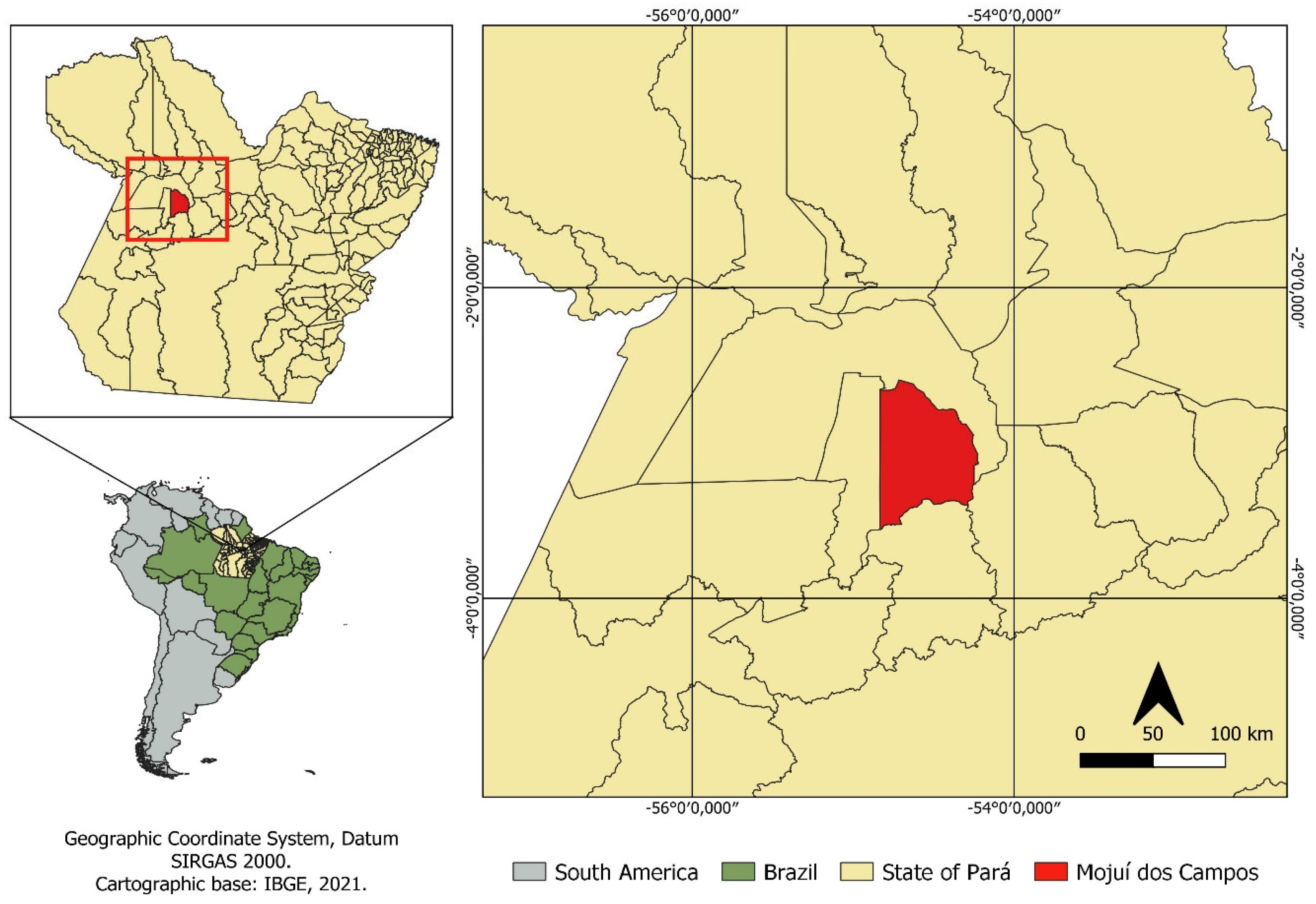
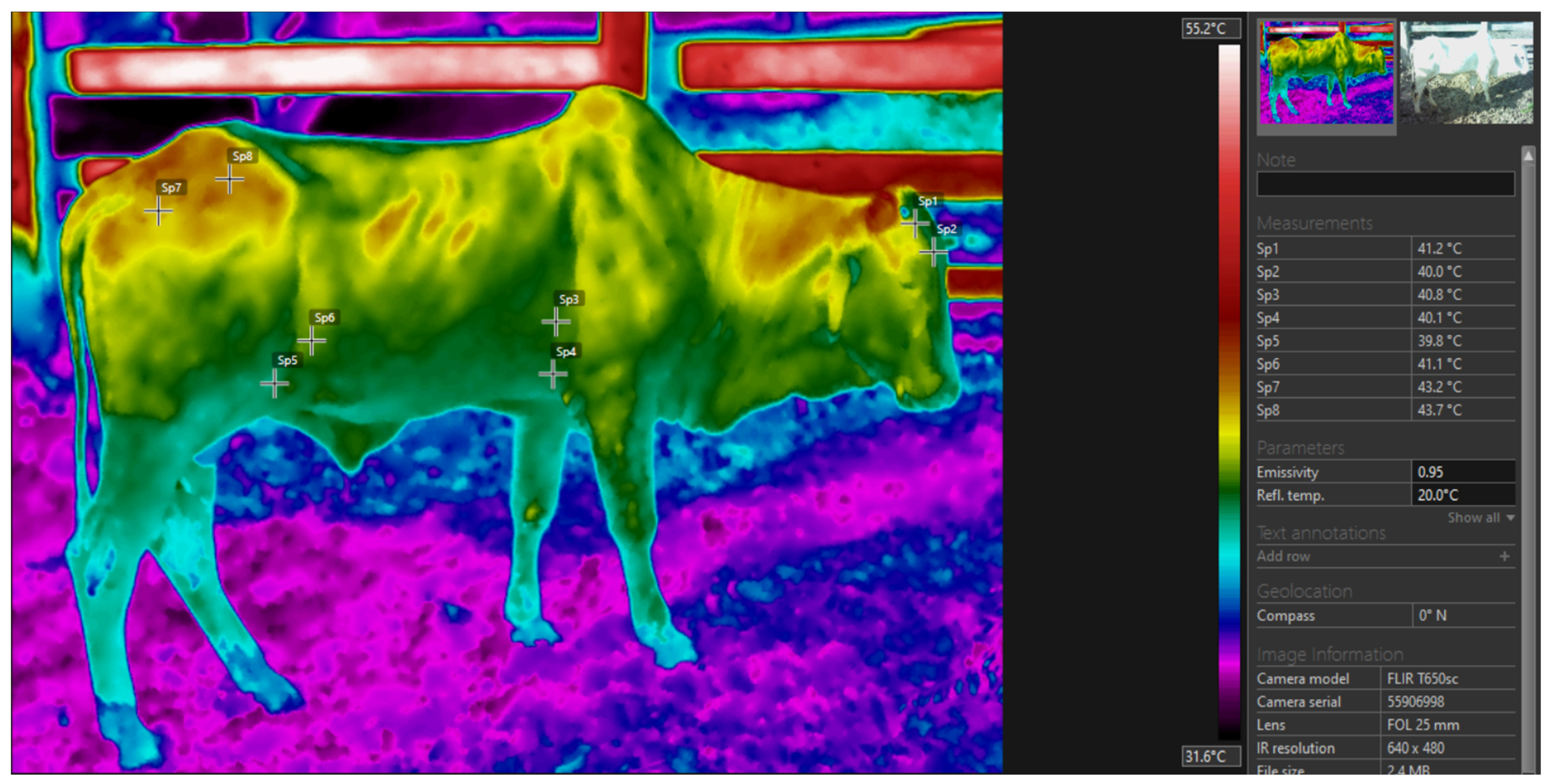

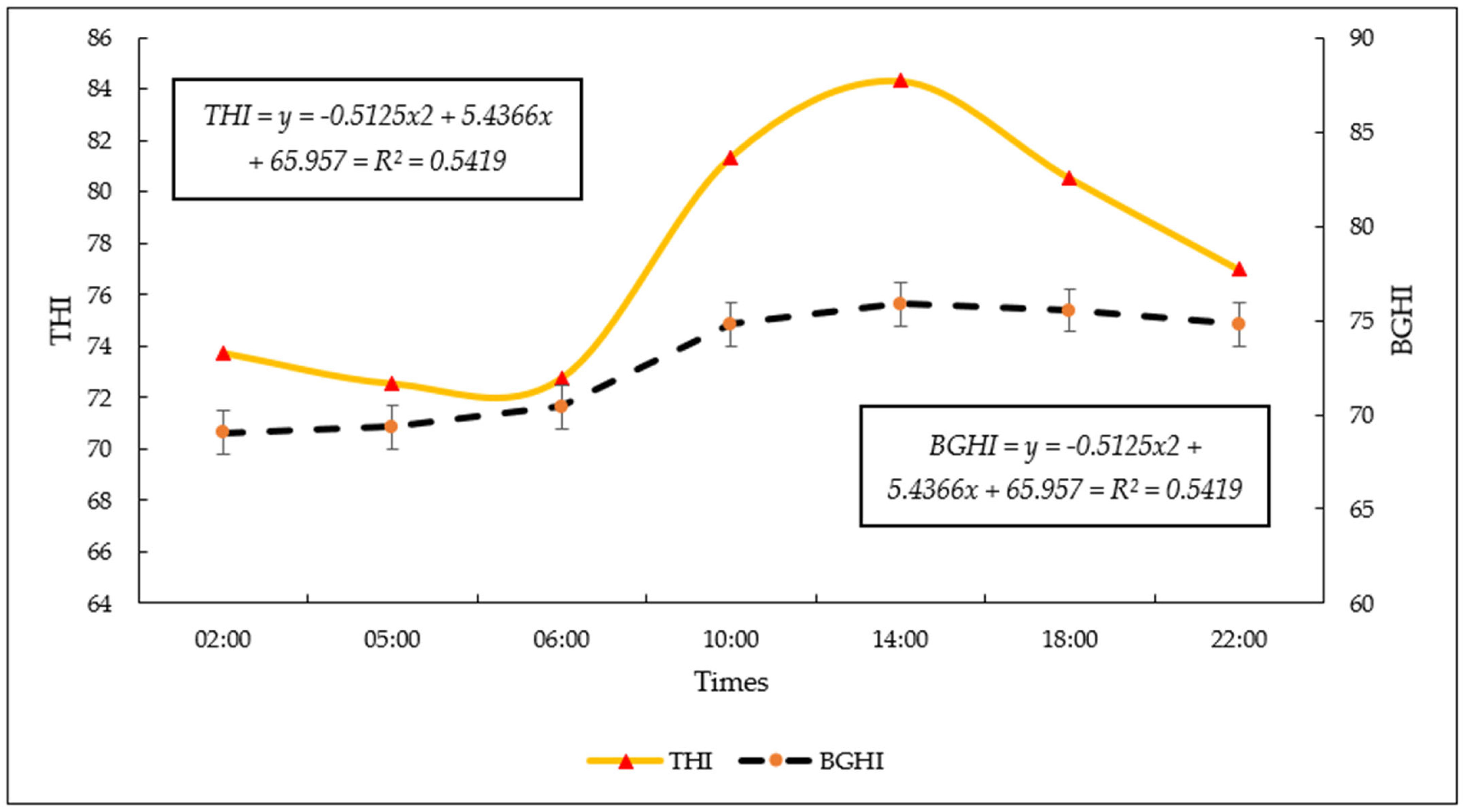
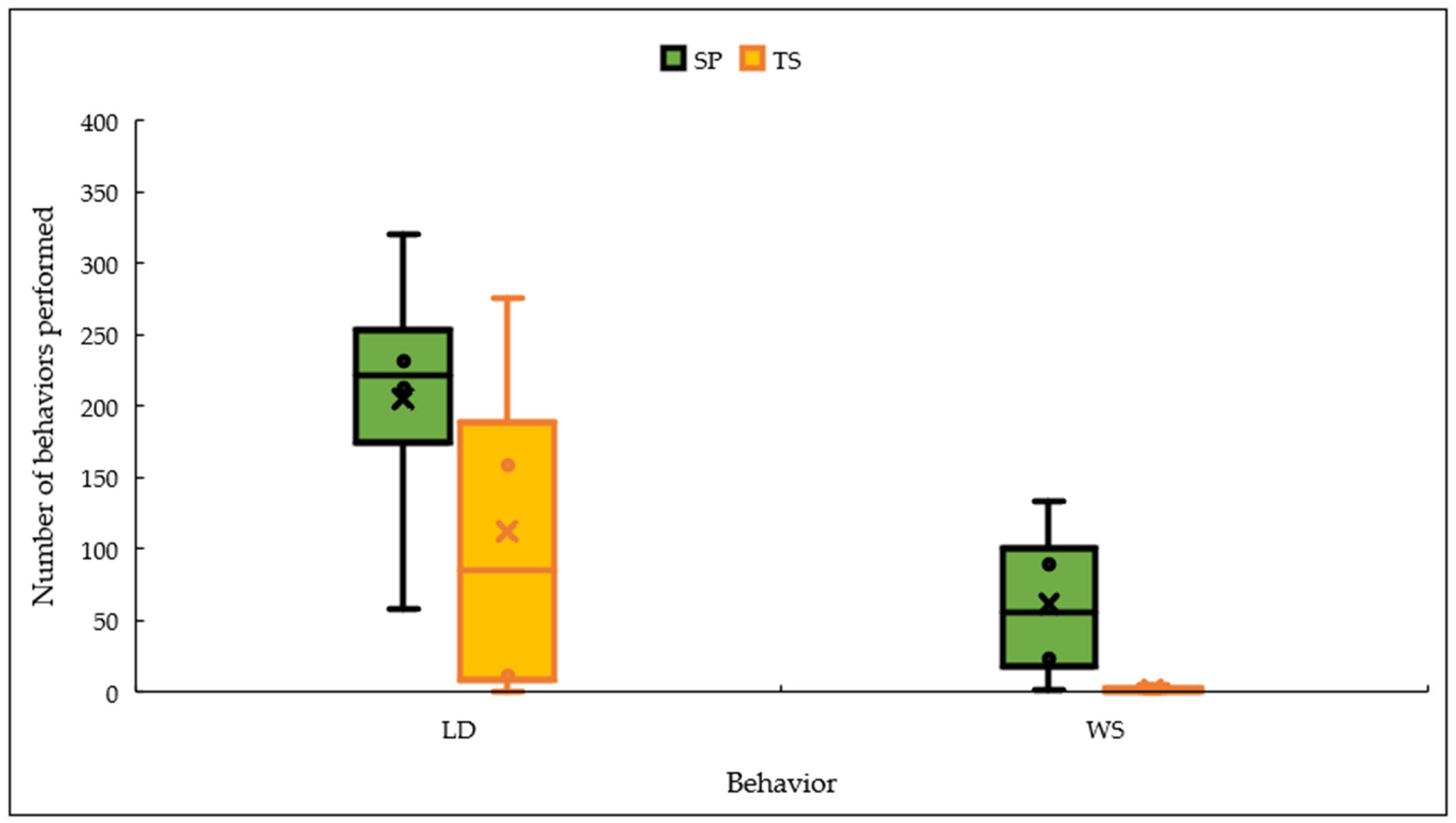
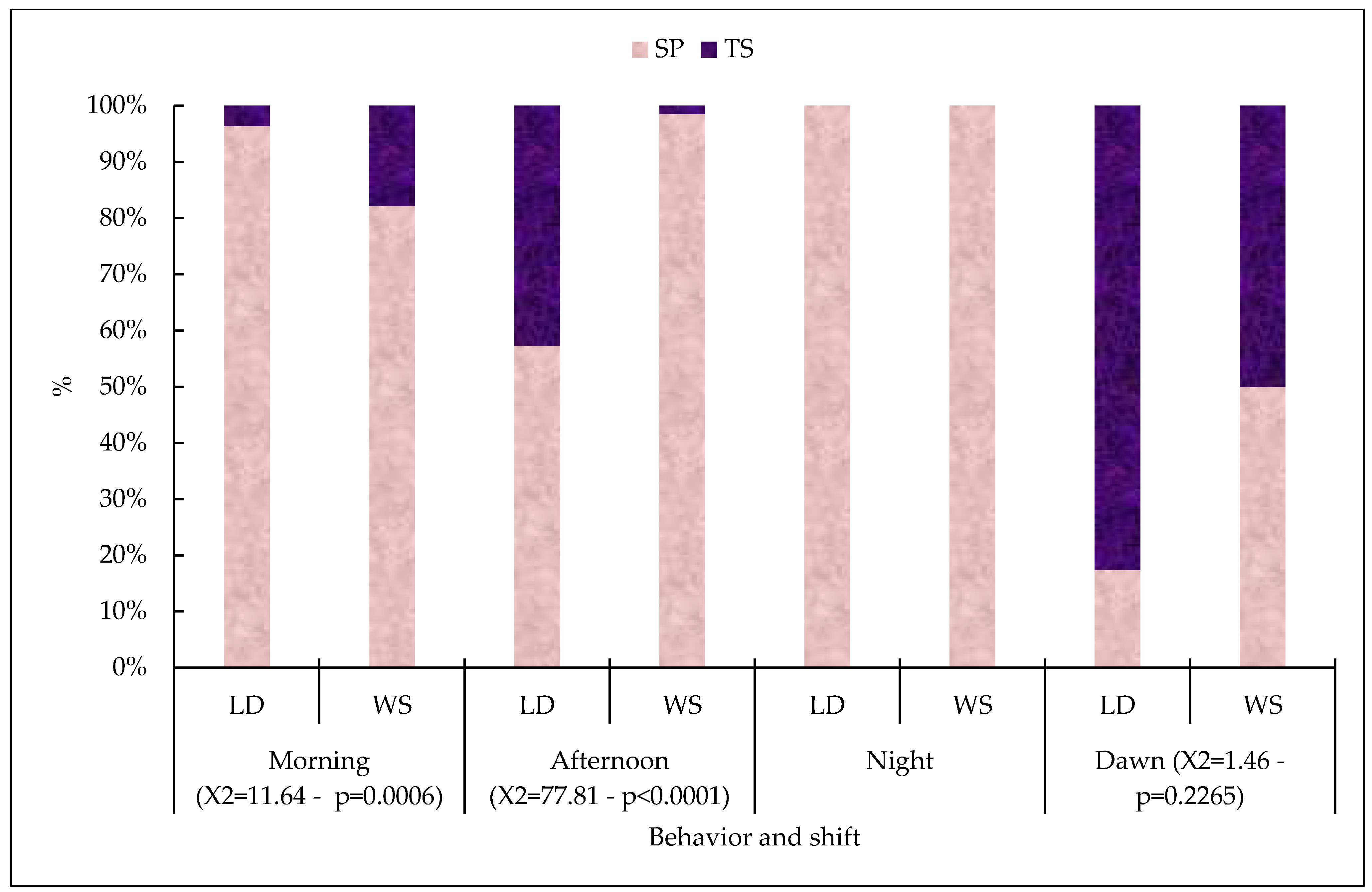

| Items (%) | System | ||
|---|---|---|---|
| Traditional | Silvopastoral | Silage * | |
| DM | 32.33 | 34.17 | 29.21 |
| OM | 91.96 | 91.96 | 91.88 |
| MM | 8.04 | 8.04 | 8.12 |
| CP | 7.69 | 6.47 | 4.22 |
| EE | 1.81 | 2.03 | 1.05 |
| NDF | 68.06 | 69.95 | 82.67 |
| ADF | 96.63 | 120.39 | 90.80 |
| Components | Quantities per 100 kg | ||
| Ground sorghum | 72 | ||
| Soybean meal | 5 | ||
| Urea | 1 | ||
| White salt | 1 | ||
| Evo core cut | 5 | ||
| Cotton pie | 16 | ||
| Total, Kg | 100 | ||
| Times | System | RT (1) | RR (1) |
|---|---|---|---|
| Average | Average | ||
| 6:00 (1) | SP | 38.80 ± 0.41 | 26.80 ± 3.91 a |
| 6:00 (1) | TS | 38.76 ± 0.29 | 38.50 ± 7.10 b |
| 12:00 (1) | SP | 39.11 ± 0.30 | 27.60 ± 2.17 a |
| 12:00 (1) | TS | 39.2 ± 0.19 | 40.50 ± 6.31 b |
| 18:00 (1) | SP | 39.57 ± 0.35 | 32.80 ± 3.42 a |
| 18:00 (1) | TS | 39.55 ± 0.29 | 39.60 ± 5.05 b |
| 0:00 (1) | SP | 39.29 ± 0.38 | 30.80 ± 3.79 a |
| 0:00 (1) | TS | 39.12 ± 0.32 | 35.80 ± 2.39 b |
| Standard Error | 0.1036 | 1.0241 |
| Variables | Strength of r and p-Value | AT | RH |
| RT—SP | r | 0.31507 | −0.25681 |
| p-value | 0.0477 | 0.1097 | |
| RT—TS | r | 0.19143 | −0.10024 |
| p-value | 0.2367 | 0.5383 | |
| RR—SP | r | 0.08825 | −0.14135 |
| p-value | 0.5882 | 0.3843 | |
| RR—TS | r | 0.05727 | 0.03596 |
| p-value | 0.7256 | 0.8257 | |
| Variables | Strength of r and p-Value | Comfort Index | |
| THI | BGHI | ||
| RT—SP | r | 0.35583 | 0.42873 |
| p-value | 0.0242 | 0.0058 | |
| RT—TS | r | 0.26759 | 0.51015 |
| p-value | 0.0951 | 0.0008 | |
| RR—SP | r | 0.05978 | −0.06537 |
| p-value | 0.7140 | 0.6886 | |
| RR—TS | r | 0.14128 | 0.44908 |
| p-value | 0.3845 | 0.0037 | |
| Times | SP | TS |
|---|---|---|
| Average | Average | |
| 00:00 | 31.2 ± 7.25 a | 32.4 ± 6.09 a |
| 06:00 | 26.4 ± 6.58 b (1) | 41.4± 9.61 a |
| 12:00 | 25.6 ± 2.06 b | 39.8 ± 10.08 a |
| 18:00 | 35.6 ± 6.65 a | 39.6± 8.09 a |
Disclaimer/Publisher’s Note: The statements, opinions and data contained in all publications are solely those of the individual author(s) and contributor(s) and not of MDPI and/or the editor(s). MDPI and/or the editor(s) disclaim responsibility for any injury to people or property resulting from any ideas, methods, instructions or products referred to in the content. |
© 2024 by the authors. Licensee MDPI, Basel, Switzerland. This article is an open access article distributed under the terms and conditions of the Creative Commons Attribution (CC BY) license (https://creativecommons.org/licenses/by/4.0/).
Share and Cite
da Silva, W.C.; da Silva, J.A.R.; Martorano, L.G.; da Silva, É.B.R.; de Carvalho, K.C.; Sousa, C.E.L.; Neves, K.A.L.; Júnior, R.N.C.C.; Belo, T.S.; de Santos, A.G.S.; et al. Thermal Comfort of Nelore Cattle (Bos indicus) Managed in Silvopastoral and Traditional Systems Associated with Rumination in a Humid Tropical Environment in the Eastern Amazon, Brazil. Vet. Sci. 2024, 11, 236. https://doi.org/10.3390/vetsci11060236
da Silva WC, da Silva JAR, Martorano LG, da Silva ÉBR, de Carvalho KC, Sousa CEL, Neves KAL, Júnior RNCC, Belo TS, de Santos AGS, et al. Thermal Comfort of Nelore Cattle (Bos indicus) Managed in Silvopastoral and Traditional Systems Associated with Rumination in a Humid Tropical Environment in the Eastern Amazon, Brazil. Veterinary Sciences. 2024; 11(6):236. https://doi.org/10.3390/vetsci11060236
Chicago/Turabian Styleda Silva, Welligton Conceição, Jamile Andréa Rodrigues da Silva, Lucieta Guerreiro Martorano, Éder Bruno Rebelo da Silva, Katarina Cardoso de Carvalho, Carlos Eduardo Lima Sousa, Kedson Alessandri Lobo Neves, Raimundo Nonato Colares Camargo Júnior, Tatiane Silva Belo, Ana Gizela Souza de Santos, and et al. 2024. "Thermal Comfort of Nelore Cattle (Bos indicus) Managed in Silvopastoral and Traditional Systems Associated with Rumination in a Humid Tropical Environment in the Eastern Amazon, Brazil" Veterinary Sciences 11, no. 6: 236. https://doi.org/10.3390/vetsci11060236








